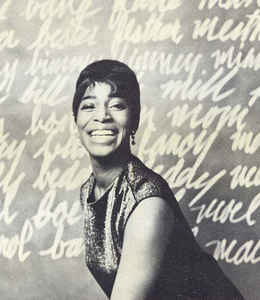Shirley Ellis and ‘The Nitty Gritty’

It starts with the buzz of a crowd, a splash of cymbal, and a snare-drum roll. For a second or two, it sounds like a circus warming up. But then a deep rhythm kicks in, with a heavy emphasis on the “one” and a double handclap on the backbeat. And a no-nonsense female voice speaks up: “Some folks know about it, some don’t / Some folks learn to shout it, some won’t.” In response, a bass voice provides an echo, doo-wop style: “Some don’t… some won’t.” Then you get the female backing singers, the double-time soul clapping under strict instruction: “Double beatin’, keep repeatin’, right down to the real nitty gritty.” South-of-the-border trumpets join in with Latin triplets, and the crowd noise rises until there’s a kind of delirium going on as the track fades after a mere two minutes and 14 seconds.
That’s Shirley Ellis’s “The Nitty Gritty”, one of the most intriguing singles of the ’60s: a whole tribal rite contained in a 45rpm side. It doesn’t matter whether or not the crowd noise was overdubbed. I remember its electrifying effect on me when I heard it in September 1963, at a time when a new wave of soul music was breaking out of Detroit, Chicago and New York. And yet it seemed different, perhaps because it was an independent production that wasn’t part of a specific “sound”.
Born in 1929 in New York to parents from Montserrat and the Bahamas, Shirley Ellis grew up in the Bronx and began her career as a singer and songwriter in her teens, winning the celebrated talent contest for amateurs at the Apollo Theatre. In 1959 she met Lincoln Chase, another New Yorker of Caribbean parentage, who became her co-writer and manager. “The Nitty Gritty” was their first US hit, reaching the US top 10 on the Congress label, and it was followed in 1964 by “The Name Game”, which made the top three, and 1965 by “The Clapping Song”, which made the top 10 in both the US and the UK.
“The Name Game” and “The Clapping Song” were based — like the Jaynetts’ “Sally Go ‘Round the Roses” (1963) and the Dixie Cups’ “Iko Iko” (1965) — on children’s playground rhymes. Ellis and Chase emphasised the syncopations inherent in both songs, helped by magnificent playing from their New York session men, under the baton of the great Charlie Calello, who arranged and produced both sides (“The Nitty Gritty” had been supervised by Hutch Davie). In “The Clapping Song”, the rhythm was in the stressed words: “Three six nine, the goose drank wine / The monkey chewed tobacco on the street-car line / The line broke, the monkey got choked / And they all went to heaven in a little row boat…” Any child who learnt that rhyme was absorbing a sophisticated groove, a variant of the hambone (Bo Diddley) beat.
Ellis made a number of other singles, only one of which, the hard-driving “Soul Time” (1967), was in the class of those first three hits. Nevertheless before she retired from performing in 1968 she had recorded enough sides of sufficient quality for Ace Records’ Mick Patrick to compile a 24-track CD titled Three Six Nine: The Best of Shirley Ellis. Comprehensively annotated by Harry Young, it gives a good all-round view of a singer who began by wanting to emulate Sarah Vaughan and ended up becoming famous for her high-grade novelty hits. “The Puzzle Song” and one or two others may have stretched the formula beyond its useful limits, but there’s a great up-tempo version of Sam Cooke’s “Bring It on Home to Me”, a hip-swinging uptown soul arrangement of Lou Christie’s “Back Track”, and a nice treatment of Barbara Mason’s swooning “Yes I’m Ready”.
She died in 2005, aged 76, having left a small but lasting mark on one of pop music’s golden ages. And “The Nitty Gritty” still sounds like nothing else you ever heard.

What an elegant description of a great song Richard!
Sounds like it had the same effect on you as it did on me in 1963 age 18.I still play, and enjoy, the two singles I have (12″ and 7″) quite frequently but can’t help thinking 24 Shirley Ellis tracks just might be 20 too many!
If push came to shove, I’d take the version Gladys did. If only for that Robert White (?) riff.
Looking for a video of the song, came across this pretty terrific dance interpretation with Bobby Banas, taken from The Judy Garland Show (1964): https://youtu.be/P2v8IgJdsm4
Would not agree that 24 Shirley Ellis tracks is 20 too many. Great voice and a stalwart of Northern Soul. Also worth checking out is “Sugar – Lets Shing a Ling” from 1967. Good to see an excellent review of an underrated artist.